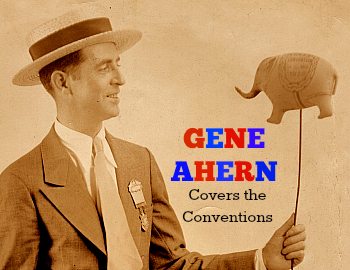 You might have missed this. Gene Ahern, a popular newspaper cartoonist covered the tense, rancorous presidential nominations by sending Major Hoople, his Our Boarding House comic strip character, to the Republican and Democratic national conventions. It’s understandable if you didn’t happen to catch Ahern’s coverage in the funny pages. After all, it happened in 1928. That was a long time ago, in terms of American politics. But the presidential race of 2016 is similar to that long ago race between Herbert Hoover and Al Smith. According to Edgar E. Robinson’s The Presidential Vote 1896-1932, the 1928 presidential race was one in which “each candidate faced serious discontent within his party membership, and neither had the wholehearted support of the party organization.” Sound familiar? Beyond this similarity, the ensuing years have not diminished the amusement one can find in reading these cartoons and columns devoted to puncturing the hot air balloons of national politics.
You might have missed this. Gene Ahern, a popular newspaper cartoonist covered the tense, rancorous presidential nominations by sending Major Hoople, his Our Boarding House comic strip character, to the Republican and Democratic national conventions. It’s understandable if you didn’t happen to catch Ahern’s coverage in the funny pages. After all, it happened in 1928. That was a long time ago, in terms of American politics. But the presidential race of 2016 is similar to that long ago race between Herbert Hoover and Al Smith. According to Edgar E. Robinson’s The Presidential Vote 1896-1932, the 1928 presidential race was one in which “each candidate faced serious discontent within his party membership, and neither had the wholehearted support of the party organization.” Sound familiar? Beyond this similarity, the ensuing years have not diminished the amusement one can find in reading these cartoons and columns devoted to puncturing the hot air balloons of national politics.
Here’s a two-day sequence in which the incorrigible Hoople is first barred from entry into the RNC, and then finds a way in by impersonating a southern senator – an impression aided by Hoople’s natural tendency towards puffery and bluster.
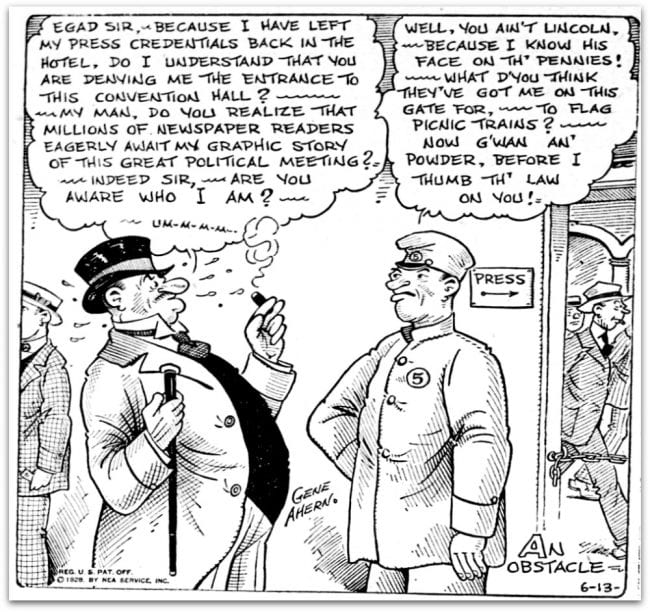
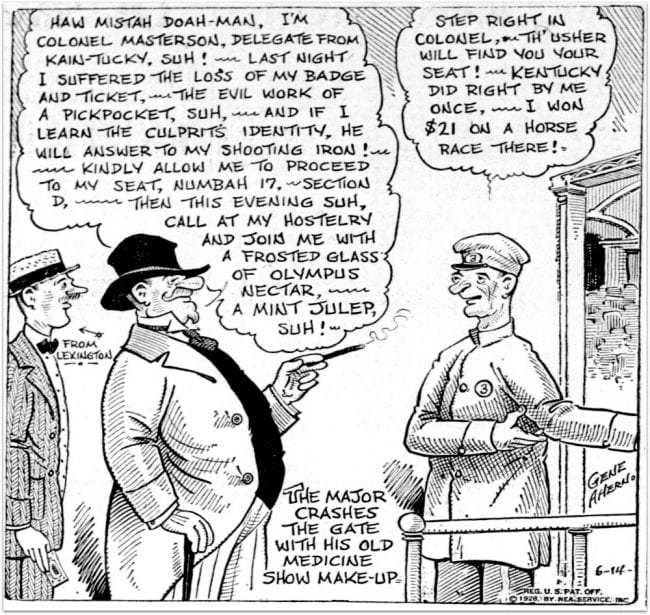
A Quaff of Aqua
In addition to setting his daily syndicated cartoon panel at the two conventions, Ahern, who attended both conventions in person, also wrote a series of comic prose reports during the summer conventions. Here’s Ahern, writing in the W.C. Fields-like persona of Major Hoople, on July 13, the second day of the Republican National Convention in Kansas City, in a column entitled "Major Hoople Misses Nothing At Convention."
“Egad, folks, after a sound night’s sleep in the barber chair at the Muehlebach Hotel I woke refreshed, ready for the task of prodding the G.O.P. Elephant into motion at the Convention Hall. The session opened with a prayer. And a writer next to me with Democratic leanings, said the contribution plate would probably follow, and as I was parched with thirst, I quietly slipped out for a quaff of aqua.”

This last passage contains a sly joke that may be lost on current readers. Prohibition was effect in 1928 and would not be lifted for another five years. It is very likely the Major is hinting he lifted said elbow to imbibe the fruits of John Barleycorn, instead of a “quaff of aqua.”
Hoople’s communique continues, depicting a rather limp, ridiculously officious ceremony. I don’t know about you folks, but this resonates in absurdity with what I saw on live broadcasts during the days at the 2016 conventions, where the halls were sparsely populated with delegates who looked about as thrilled as people in a dentist's waiting room; people sorely in need of a quaff of aqua, or something stronger.
“Upon returning, Mme. Schumann-Heink was rendering the National Anthem in a soul-stirring manner. Knowing the Madame to be a native born of Germany, she indeed put all present to scorn, who could not carry the song in words beyond, ‘By the dawn’s early light,’ – with the exception of myself – (who has seen the dawn’s early light many a time – Editor’s note). Roy West, Secretary of Commerce, then read the by-laws for twenty minutes, and finished talking with only myself as audience.”
Readers familiar with Ahern’s daily Our Boarding House comic will recognize, in the editor’s sardonic comment, above, a device similar to the brief, cutting authorial remarks Ahern put into his panels as a kicker joke.
These columns and comics were the Colbert Report of the 1928 political conventions, chuckled at by millions of newspaper readers, who desperately needed the comic relief. These entirely fictional reports, lampoons of media coverage, appeared on the front pages of America’s newspapers alongside the factual, sober reporting of the Republican and Democratic presidential conventions.
With the 2016 conventions in our short term memories, it may serve as a bit of much needed humorous relief for some to review this long-forgotten, wickedly funny work. It might also be amusing for some to see the fun made of an eternally self-aggrandizing nut – albeit one that is more benign than a certain current political figure who also appears to be largely self-obsessed and prone to long-winded, self-glorifying speeches.
A Career Screwballist
Gene Ahern (1895-1960) had a long career as a syndicated newspaper cartoonist. He started out in 1914 working for the NEA syndicate in Cleveland, where he created a series of nonsensical daily panels and strips heavily influenced by the comics of Rube Goldberg. Strips like Dream Dope, Fathead Fritz, Balmy Benny, Squirrel Food and Otto Auto delivered non-stop nuttiness. Among Ahern’s early work was a humorous prose series, Ain’t Nature Wonderful, which presented bogus science facts and was as unconcerned with verisimilitude as Major Hoople’s 1928 convention reports.

In September 1921, at the suggestion of an editor, Ahern launched a new strip, Our Boarding House, which would prove to be his most successful creation. Ahern’s strip used the same single panel format his fellow NEA compatriot, J.R, Williams employed for his long-running Out Our Way comic, complete with sarcastic editorial comments. A full color, full page Sunday version came along about a year later in December 1922. In 1936, Ahern, now one of the top humor cartoonists, was lured away from NEA by the Hearst organization, which seemed driven to collect screwball comic artists, having also wooed NEA staffer and screwballist George Swan over in 1927 and hired Milt Gross in 1931.
With Hearst, Ahern created an ‘Earth-B” version of his popular comic, Room and Board, starring one Judge Puffle. The strip lasted until 1953. The dailies were every bit as good, if not better, than anything Ahern had done with Major Hoople. Despite that, Room and Board doesn’t seem to have ever matched the popularity and readership of the antics of Our Boarding House. Ahern did, however, create a topper strip for the Sunday Room and Board, called The Squirrel Cage, which lasted for most of the strip’s run and which represents a high point of American screwball comics – most famously featuring the white bearded Little Hitch-hiker, a version of Rube Goldberg's Old Man Alf (of the Alphabet) and a template for Robert Crumb’s Mr. Natural.
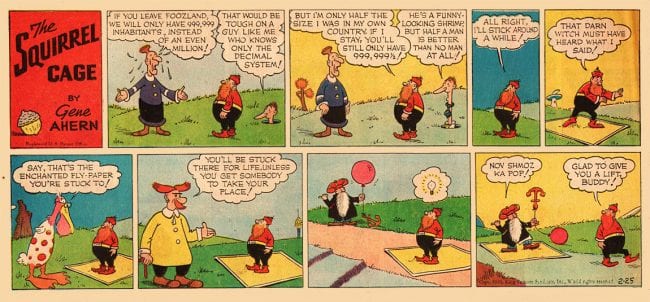
Although Ahern left Our Boarding House in 1936, enough cartoonists to populate a state’s presidential convention delegation kept it going until the strip ended in 1981. Because, for the majority of the strip’s years, it was written and drawn by people who were copying Ahern’s brilliant formula, and because it became an umpteenth generation hand-me-down, the strip has become associated with a certain diluted blandness and formulaic dullness. However, if one reads the original Gene Ahern Our Boarding House episodes, a very different comic emerges -- one that delivers a gratifying stream of vital, character-driven humor.
Comic Journalism, Of a Sort
The 1928 presidential conventions wasn’t the first time Ahern had played the role of a cartoonist-journalist.

In 1916, five years before he created Our Boarding House, Ahern covered the baseball World Series between the Boston Red Sox and the Brooklyn Robins with his Rube Goldberg-styled observational comic strip, Squirrel Food.

A decade later, in the fall of 1926, newspapers reported that:
“Major Hoople, famous cartoon character of ‘Our Boarding House,’ has packed up his old typewriter and enroute to Philadelphia where he will cover the Dempsey-Tunney fight… Gene Ahern, creator of Major and the other boarding house characters, is in Philadelphia and the cartoons depicting the Major’s visits to the camps of Dempsey and Tunney will be drawn there.”
In a two-week series, harkening back to the earlier glory days of the newspaper sports cartoons, Ahern inserted caricatures of Jack Dempsey, Gene Tunney and even the fight promoter, Tex Rickard, into his comic. Hoople dispensed plenty of advice to all involved, laced with long accounts of his own pugilistic exploits. On the day of the fight, unable to get tickets, Hoople wound up distractedly selling hot dogs ringside to see the fight – a rare example of the Major getting anywhere near an honest job.

Our Boarding House revolved around Major Hoople, a portly Falstaffian blowhard. The Major (a military title Hoople almost undoubtedly bestowed upon himself) was married to a stout, stern woman who ran a boarding house – a conceit that would allow Ahern to parade entertaining characters through the strip, as boarders came and went. The Major did not appear in the strip for the first few months, and when he finally made his appearance, he was, by far, the most entertaining character of all and the prime driver of the strip's enormous popularity. A comic figure of mythic proportions, Hoople is always scheming to avoid work of any sort. In fact, it is the avoidance of labor that convinces Hoople to attend the conventions.

A Skull Spark For Hot Air
Ahern’s 1928 convention coverage began in April. Newspapers across America announced the upcoming political conventions would be covered by a fleet of reporters, columnists, photographers, humorists and… one cartoonist: Gene Ahern. Pennsylvania’s Altoona Mirror reported “a series of humorous articles under the Major Hoople service by Gene Ahern… will prove colorful and picturesque of the most interesting developments.” In Texas, the El Paso Evening Post said, “Ahern, by the way, will be there with his famous character, Major Hoople.”
On April 17, Ahern penned his first column in the voice of Major Hoople. It began, "Egad, I am delighted, as my friend and classmate, Theodore Roosevelt, used to say, to be able to announce that the euphonious name of Hoople shall be added to those who will write special signed stories about the democratic and republican conventions." Ahern illustrated the piece, which is mostly given to a shaggy dog story about his efforts to elect a Maharajah in the fictional country of Indore, with a special cartoon depicting the Major announcing his own selections for the Republican presidential candidate to Treasury Secretary Andrew Mellon, who controlled Pennsylvania's delegates (and whose endorsement assured Herbert Hoover's nomination).

In late May, in the daily comic strip, Hoople has the idea to subsidize his trips to Kansas City and Houston by selling his reports to a newspaper editor. After all, he was one editor of the Aberdeen Evening Bagpipe. Hoople's scheme collapses when he is only offered five dollars apiece for acceptable articles, and the paper refuses to pay for his trip.

The major is nothing if not resourceful. Two days later, he has an inspiration and reveals it to a boarder who suggests the "skull spark" is about as goofy as a match with heads on both ends. The idea is to create souvenir toy novelty balloons in the shapes of donkeys and elephants and sell them at the conventions.
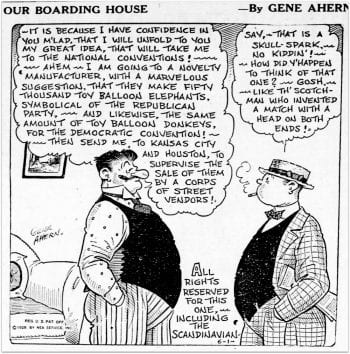
Much ado is made of the Major's scheme in the ensuing weeks, both in the strip and in the general news. Remarking on struggling farmers seeking help at the convention, one paper noted, "What the farmers expect to do at the convention is plenty. We suspect, however, that Major Hoople's balloons will attract more attention from the delegates."
It must have been incumbent on Ahern to find some way for the Major to be able to afford the trips. This necessity led to the unusual happenstance in which a scheme of the Major's actually works out. Hoople sells his idea to a novelty toy manufacturer and is suddenly well-heeled with a salary and expenses paid. The editorial comment for this cartoon reads, "Sounds like a dream -- but it isn't!"

The Major's balloon invention seems especially appropriate for both a political convention and a blowhard. A newspaper observed on June 6, "There will probably be plenty of hot air at both political conventions this year... consequently it seems eminently fitting and proper that one of the most famous hot air artists in the country should be in attendance."
The Major becomes quite full of himself. When he gets samples back from the manufacturer, he Lords it over some of the more critical boarders -- waving miniature elephants and donkeys in their faces.
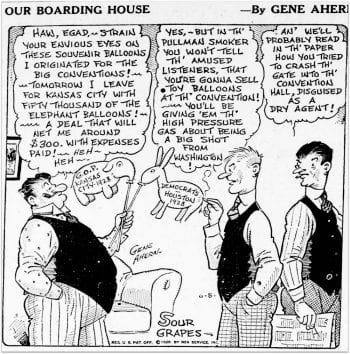
The Major leaves his hometown (which remained unidentified in the strip , as far as I know) for the big conventions on June 9, remarking to himself, "Egad' a rousing sendoff the gave me at the house! Except that tomato, thrown in jest!"
Unconventional Convention Coverage
Ahern's multi-week buildup to the conventions was perfectly paced. Now that the conventions were around the corner, he had a greater challenge. Since syndicated comic strips were normally required to be submitted weeks in advance to allow for processing and distribution to the subscriber papers, Ahern had the tricky challenge of creating topical material weeks before it actually occurred. He solved this challenge by having Hoople experience some difficulty getting into the conventions, and then mostly focussing on what Hoople does when he is not on the convention floor, "behind the scenes," as one clever promotional agent put it.
The Republican National Convention of 1928 was held in Kansas City from June 12 to June 15. The sitting president, Calvin Coolidge, was a Republican and had surprised everyone when he announced he would not run for a second term. Herbert Hoover was nominated on the first ballot. Not that any of this mattered to Major Hoople.

The last night of the convention, Hoople strikes up a poker game with some of the delegates and funds his lucky streak is still in play as he does quite well. Flush with success, the Major has room service bring him breakfast in bed and a Belvedere El Corona cigar the next morning. He winds up hiring a valet, a black waiter named Jason unfortunately depicted in the unflattering big-lipped, ignorant fashion of American cartoons of the first half of the 20th century. Ahern fills much of the time between conventions with banter between Hoople and Jason. In one instance, perhaps to remind readers Hoople would be at the next convention, the Major presents Jason with a donkey balloon, boasting of his brilliant scheme and inflating his take on the deal tenfold.

In his column,which ran once or twice a week, Ahern was able to work in more current details. The cycle time from creation to publication was much shorter for text pieces. In one column, Ahern poked fun at a congressman's boring speech:
"Senator Fess in his speech called upon a great amount of statistics -- on the increase of home owners, banks deposits, new telephones, in fact, everything but the new Ford production for next August. I offer this statistical figure of my own compiling. That 11,677,301 radios were turned off during that period of his statistical speaking."
While attending the convention in Kansas City, Ahern discovered vendors selling real life versions of Hoople's toy souvenir balloons. The NEA syndicate circulated photos of Ahern holding the Republican elephant balloon and wearing a delegate badge. These ran in numerous newspapers amongst photos of convention activities. Ahern's presence at the conventions, it seems, added a great deal of lighthearted liveliness to the reporting.
Hoople sums up the convention in word that could well apply to many such events throughout the years, stating, "...it took four days, by Jove, to ask the riddle that everybody knew the answer beforehand." Hoople ends his last Kansas City report with a P.S.: "I feel a bit disappointed. For campaign purposes between now and next November, what a rhythmic and poetical swing there would be to the combination, 'Hoover and Hoople.'"
The 1928 Democratic National Convention was held from June 26 to June 28. New York governor Al Smith was nominated, the first Roman Catholic to be nominated for president of the United States. Smith ran on a platform to end prohibition, and this was met with vehement protests on the convention floor, particularly from Texas. Hoople again has difficulty getting in -- his impersonation of a Hawaiian delegate failing to impress the jaded doorman.

In his first column from the Democratic National Convention in Houston, the self-obsessed Hoople basks in the cheering of a swarming crowd of thousands, unaware they are actually welcoming the colorful New York mayor Jimmie Walker. Hoople then provides the reader with convention news:
"Well, I know you are quite anxious for my expert analysis of the political situation here. Through what I can gather, it appears from street corner conversation there is some talk of nominating a man by the name of Smith, I believe, for the Democratic choice. This, however , may just be idle prattle. I surmize that they are groping first for suitable names of a likely candidate, beginning with Smith, Jones, Brown, etc. and finally ending up with an executive grandiose-sounding name like Jefferson -- or better yet, Hoople. Har-r-rumf."
Hoople also explains that his hotel is a nine-block walk from the convention hall and he has discovered passing taxis charge for extra passengers, "draft it." Hoople gleefully shares his solution to this dire problem: "I have produced a pair of crutches in hopes that some kindly soul with an auto may take pity and give me a lift to the hall." He spends much of the next day's column chastising the city of Houston for all the walking he is forced to undertake.
He reports that the convention hall, located in one of our southernmost cities during the hottest season, "is a marvellous structure with open sides, allowing the breezes to waft through and enable the spectators to enjoy a refreshing snooze during the speeches."
Snoozing, in fact, seems to be Hoople's downfall. In the daily strip, he seems to sleep through most of the convention, recovering from a hang-over, with his valet Jason, nursing him along. By the time the major is back on his feet, the convention is over and he is ready to head home. He sends a wire to the boarders, indicating he will be arriving with a surprise. Naturally, the boarders, a pair of Vaudeville comedians, crack wise:

However, Hoople's surprise -- his valet, Jason -- who has come home with him, leaves the boarders speechless, for once.

Jason hangs around the strip for a few days and then vanishes without explanation, as Hoople takes him one night to the Owl's Club, where he figures Jason might find a few new clients for his services. It is never explained what happens to Jason. Meanwhile, Hoople engages in a subtle war with the other boarders as they attempt to take a summer vacation without him. They lose, of course.
For his last convention article, published on June 27, Ahern provided a climactic wrap-up in which he let his powers of screwball comedy loose. With solemn sincerity, Hoople proposes his own program for future political conventions. He begins by suggesting the national convention take place on a giant ocean liner, covering a six weeks voyage to the Mediterranean. He suggests the credential committee (presumably the cause of his troubles entering the conventions as a delegate alternate) take a dirigible to the polar regions during the six-month night period.
From this point, the Major's suggestions get even nuttier. He suggests the reading of the majority and minority reports be accompanied by a music (a suggestion modern convention organizers seem to have perhaps taken seriously, given how large a role music played in the 2016 conventions). The Major suggests "the choice of convention chairman be settled by a wrestling match," that "the keynote speech be given by a ventriloquist," and that "the platform speech be sent out by circular letter to wrong addresses."
When one pauses to consider the continual evolution of American politics as entertainment, perhaps the Major was on to something.
Best all, the Major suggests "the nominating speeches of a candidate be limited to the truth, which would only require three minutes to deliver at the most."
In November, Herbert Hoover won by a landslide. In all, Gene Ahern wrote ten humorous columns and created about three months of daily cartoons around the 1928 national political conventions. The names and political issues may be different from those of today, but the underlying humor Ahern found in this uniquely American quadrennial event is timeless.

+++++++
Paul Tumey is a writer, artist, and designer who lives in Seattle, Washington. He has run his own presentation design business, Presentation Tree, since 1999. His comics history work appears in THE ART OF RUBE GOLDBERG (Abrams ComicArts, 2013), which he also co-edited. He also wrote the introduction to THE BUNGLE FAMILY 1930 (IDW, 2014). He contributed an essay to SOCIETY IS NIX (Sunday Press, 2013), and was also a contributing editor, researching and writing mini-bios of over 50 obscure cartoonists. He served as an essayist and associate editor of IDW’s KING OF THE COMICS: ONE HUNDRED YEARS OF KING FEATURES SYNDICATE. Most recently, Tumey wrote an essay on Dick Tracy that will appear in the forthcoming volume from Sunday Press. He writes a regular column called FRAMED! for The Comics Journal at www.tcj.com. He is currently at work writing a book about the great American screwball cartoonists, which will include Gene Ahern.







